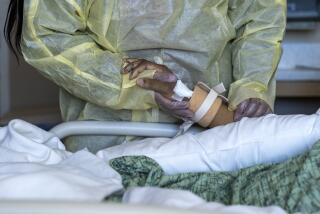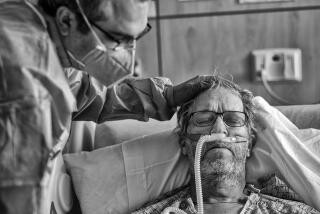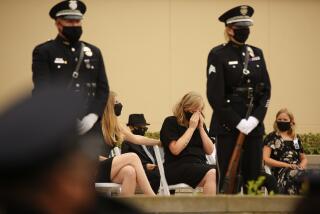‘We are used to death ... but not on this scale’: An oral history of the coronavirus crisis
As the coronavirus spread through New York City this month, doctors and nurses saw and heard things they had never encountered before — waiting rooms filled with hospital beds, growing death tallies, one colleague after another falling ill.
In a series of interviews over 10 days, doctors and nurses in the Mount Sinai Health System recounted how they faced crushing workloads and unrelenting tragedy. But as the days progressed, rare uplifting moments came too, along with the thought, and hope, that things might just be getting better.
Here, in their own words, are scenes from the U.S. epicenter of the pandemic.
April 1. “We are used to death ... but not on this scale.”
Dr. Peter Shearer, Mount Sinai Brooklyn:
We are used to death. It’s not unusual, but not on this scale. We were walking to a meeting, me and a couple of colleagues, and we walked past transport workers who were taking a deceased patient to the morgue truck. We have a refrigerated truck to hold the bodies because so many people are dying. After we got a bit down the hall, I turn to the others and asked: “Did we just walk by a dead body and nobody recognized it?”
Dr. Charles Powell, Mount Sinai Hospital in Manhattan:
The major challenge is the volume of patients that are so sick. We have never encountered anything like this before. We are not equipped for that at a baseline. We are building an entirely new ICU in our lobby. I looked at it the other day. We have built others in the hospital. One day they are going up. And the next day they are full of patients.
April 2. “They look sad and they look tired.”
Dr. Shearer:
Today I learned there was a married couple in the morgue truck. That is the second couple who has died at our hospital. I also spoke to our transport staff. I told them they were doing a good job and talked about how screwed up everything is. Then I teared up.
I never tear up at work. The married couple in the morgue didn’t make me tear up, though, but giving that talk did.
Dr. Powell:
I walked into the medical intensive care unit today and everyone was kind of down. A 62-year-old patient had just died of a cardiac arrest. He had been showing signs of improving. All of the sudden his heart rate dropped and everybody rushed into the room and tried to resuscitate him and couldn’t do it. He was the second patient to die in there today.
You could see the pain on the faces. Well, really in the eyes, particularly in the nurses’ eyes, because that is all you can see through all the PPE [personal protective equipment]. They look sad and they look tired, and you can tell this has been very draining, physically and emotionally, on them just by their eyes.
April 3: “Don’t stop. Just one more.”
Nurse Camille Davis, Mount Sinai Hospital in Manhattan:
I was thinking about my first death. It was a couple of weeks ago. And we were not allowing families into the rooms, so I wanted to let this man’s family see him before he died. So I put my own phone into a Ziploc bag and used FaceTime to talk to his wife.
His wife said, “I love you, I love you.” And he opened his eyes to that. I was crying so much that I had to tell the wife I had to cut the conversation short. I still feel bad about that. That night he expired.
Dr. Powell:
Today I saw something I had never seen before in the medical ICU. On the windows to the rooms we list important lab test results, things like that. Next to those results on the rooms were written things about the patients, personal things. On one window someone had written: ”My name is Steve and my friends call me Stevie. My wife is so-and-so. And the love of my life is my granddaughter.”
Nurse Davis:
The window to a patient’s room said he had just had a grandbaby, and he loved R&B and had five grandchildren and four grown children, and he liked to go to Atlantic City.
His heart stopped, and we did CPR for literally 45 minutes. And the attending doctor said, “Well, I think it’s time we stop.” And I said, “Don’t stop. Just one more.” That note made it impossible to stop. So we kept fighting. But he died anyway.
Dr. Glen Chun, Mount Sinai Hospital in Manhattan:
I had a patient who was trending in the right direction. And then Saturday morning, he became acutely sick. Just like that. His fever spiked to 104. He had been fighting fevers, but nothing this high. His blood pressure suddenly shot down. He was in a profound degree of shock. Finally, his heart gave out. It had been like he had just run five marathons.
Figuring out how a patient will do is very difficult. I want to discharge people but find myself getting nervous about whether they will get worse at home and come back.
Dr. Shearer:
We definitely prepared for the initial patients. But those first 10 quickly became 100. And now more than 200. Between yesterday and today, we had 14 deaths and are chock-a-block full of patients. It feels better than last week, as surprising and crazy as that sounds.
April 6: “The things we wear.”
Dr. Chun:
Getting your gear on works like this: You first wash your hands. You make sure they are clean. Then you put on your cap and tie it up and put on your N95 mask. You make sure it’s pinched as tight as you can make it. You don’t want any gaps for the virus to slip through.
These masks can really dig into your skin. People don’t appreciate how much skin they can tear off. I saw some skin peel off a doctor the other day. It can be very uncomfortable. Then you put on a surgical mask over it.
Then you put on your face shield. After your face shield, you wash your hands again. And then you put on a pair of gloves. You get in your gown. Tie it up. And you put on another pair of gloves. The gloves and the gown come off between patient visits. These are the things we wear.
It’s not 100%, and you are always paranoid about making a mistake. I remember my first patient with covid and looking at the results of his test on the computer and getting nervous. The first thing I thought of: Did I make sure I did everything right in the donning and doffing? Did I touch my face? Did I wash my hands long enough? Now, you don’t really think of those things because you are awash in it.
Nurse Robert Lynch, Mount Sinai Brooklyn:
It’s interesting when someone codes — that means their heart stops. Usually a whole team races to a patient. But now, because everyone is so busy with so many patients, it’s often just a nurse, a doctor and a respiratory therapist trying to save the person.
I have never experienced that before.
Dr. Shearer:
Our long-term radiologist died. He got admitted to Mount Sinai and was in one of the intensive care units. I knew he wasn’t doing well. He was in his 70s. A very nice guy. I called our chaplain — a rabbi — to maybe talk with the staff about it. And the rabbi and this radiologist had been friends for 50 years, and so the guy I was going to to help my staff was traumatized himself.
I remember three or four weeks ago, I was biking to the hospital ... and I saw the radiologist crossing in front of me in the crosswalk. And now he is dead.
Dr. Powell:
Everyday, I get a list of patients who died at Mount Sinai. Usually, it’s one or two names. It was 20 today ... 20. That is so striking and so terrible.
April 7: “We didn’t use a body bag today, so that is a victory.”
Nurse Davis:
On Monday, I got in a little trouble because I gave a body bag away from my unit to some nurses who needed one. Our unit had started with 10 on Friday. By Sunday we were down to 6. Now, because I gave one away, we had five. So I had to hide them. Imagine that, I had to hide body bags. But we didn’t use a body bag today, so that is a victory, a real victory. No one died today!
Right now, I’m delivering pizzas to other wards in the hospital. A donor sent our unit 50 pizzas. Honestly, we are getting too much pizza. We are all going to get fat. Every night we get a huge order of pizzas. We could eat maybe two or three, but not 50, so now I’m in an elevator delivering them. You know what? That feels really good.
Dr. Shearer:
Our administrative director is a very sweet, hard-working guy. He is very concerned about a security guard who has covid and came into the ER. A few weeks ago, we had one of our first covid patients. He was an alcoholic. I helped him put on his shoes, and suddenly he grabbed and tried to attack me. Security was called. He calmed down. And then he just sucker punched the administrative director in the eye. The director soldiered on.
He is worried about this security guard. He is asking all kinds of questions about him. The security guard getting sick bothers him more than getting clocked in the face.
April 8: “The tide is turning.”
Dr. Shearer:
A dog visited the hospital, a comfort animal. Moby. He came out for the staff. We pet him, all that. It was very nice. It was the only thing better than my own dog, who is 300 miles away with my husband and son in Provincetown, Mass. They are running and playing on the beach.
Dr. Powell:
Today was great because it’s the first time I feel like the curve is turning, the tide is turning. Today is the first day the number of people in our hospital system was lower. For the fourth day in a row, the increase in total admissions was down. We may soon hit, or have already hit, the peak. We are not exhaling, but we are breathing a little easier.
Nurse Davis:
There was a patient whose family was going to Zoom, so I went in and drew the blood, checked to see if he was soiled and set up the iPad. And one of his daughters was kind of struck that the patient’s face was swollen. It upset her and she was crying. I had tried to hide it by the way I had position his head and his bed and the iPad. We try to take care of the patients, putting on lip gloss, brushing hair, that kind of thing. Not to hide the condition. Just for dignity.
I didn’t cry today on any of the calls with families. So that is very good.
April 9: “This big historic thing”
Dr. Shearer:
I’ve been thinking how I have been at the center of this storm. I am at the center of a tornado that has been moving across the globe, and it has settled upon Brooklyn for a few days.
I have a friend who is an ER doc in Denver. He used to work here. We were talking, and he said he felt like he was missing out, that there was this big historic thing going on in New York City and he felt he wasn’t being part of it. And that got me thinking that I’m part of this process and it feels meaningful.
Dr. Chun:
I had a surreal experience. We have a patient who was not going to make it, and we spoke to the family to get permission to remove the tube and let him die. The daughter had a request for me: Would I go into the room and speak to her father for her. So I went into the room with a nurse and said: “Your daughter loves you. She thinks you were the best person she has ever known. She cannot wait to see you in heaven.”
He died before we could remove the tube.
April 10: “The best we can.”
Nurse Davis:
We have a 42-year-old who is not doing well, but he is a doctor so we are throwing the book at him. They are going to recirculate his blood to oxygenate it. He is already on maximum oxygen. If I end up here, they better throw the book at me, do everything they can.
I was crying the other day, and a doctor told me: “Camille, you can’t beat yourself up. We are doing the best that we can.” And I have been holding on to that.
More to Read
Sign up for Essential California
The most important California stories and recommendations in your inbox every morning.
You may occasionally receive promotional content from the Los Angeles Times.









